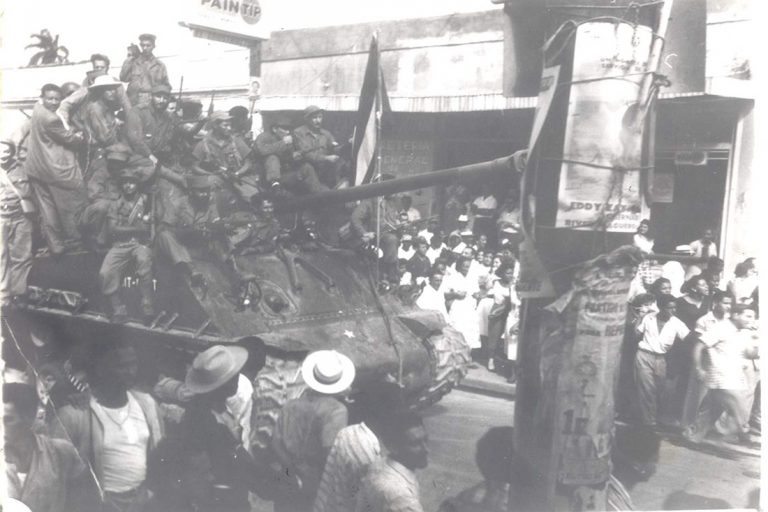By: MsC. José Fernando Crespo Baró y Lic. Daris Rondón Laurencio
On January 2nd, 1959 from Guáimaro, one of the first guidelines issued by Commander-in-Chief Fidel Castro Ruz at the head of the Freedom Caravan, proved the character of a true democratic Revolution for the people and by the people, in the that the greatest leader insisted, the guarantee of supplies, the dismantling of the military and repressive apparatus of the dictatorship; as well as the need to prosecute supporters of the tyranny, among other measures. While in the city, the people of Camagüey waited for the arrival of Fidel.
Two days later, on January 4th, the Commander-in-Chief stormed the streets of Camagüey from the Caridad Square and Avenue. That same day at night he gave an emotional speech in the Caridad Square that would be kept in the memory of the grateful people of Mayor Ignacio Agramonte Loynaz. [1] From that singular moment, Fidel would recall: “There is a matter of spontaneous sympathy on the part of the people of Camagüey, because that was demonstrated upon our arrival. [2]
From then on, there were uninterrupted parades, popular and labor rallies, massive events in support of the Revolution, as well as fundraisings to contribute to the implementation of the Agrarian Reform and the Literacy Campaign.
So throughout the year, the people of Camagüey gave fervent displays of total support for their greatest leader and the triumphant Revolution of January. From now on nothing would be easy, however, the courage, resistance and optimism of the people of Camagüey would continue to promote and defend the revolutionary work. One of those tests of stoicism and loyalty was given by the people to defeat the counterrevolutionary conspiracy plotted by a traitorous commander who was disloyal to Fidel’s trust. On that occasion, in the overflowing streets of Camagüey, the people would accompany Commander in Chief Fidel and Commander Camilo Cienfuegos to disrupt the conspiracy and defend their revolution.
Fidel and the people
Another test would come, the mercenary invasion by Playa Girón. Once again, militia women and men from Camaguey would take up rifles in defense of freedom, national sovereignty, and the socialist nature of the Cuban Revolution. New tasks and missions would be carried out by the children of Camagüey.
Fidel would return to the city of the waterpots in November 1959. In the Cuban capital, tribute was paid to the martyrs of November 27th, 1871. In Camagüey, the old headquarters of the Military Regiment No. 2 would be handed over by the revolutionary leadership to the Ministry of Education.
On that occasion, Commander in Chief Fidel, the President of the Republic Dr. Osvaldo Dorticós Torrado, the Minister of Education Dr. Armando Hart Dávalos, commanders Juan Almeida Bosque and the head of the Second Military District Pedro García Peláez, captains Orestes Valera and Jorge E. Mendoza, the provincial coordinator of the July 26th Movement Dr. Raúl García Peláez, hundreds of farmers, members of M 26-7, among other assistants. In Fidel’s words, the center would be named “Cándido González” School City.
In Fidel’s momentous speech, he had a pondering phrase about the land of the Major: “With Camagüey, the Revolution will always be able to count on to the last drop of his blood.” [3]
In other moments of his words and among repeated ovations he predicted: “A better future will come, what our country had never had will come, full national sovereignty will come forever, schools will come, culture will come, work will come, wealth for our people, the land will come for our farmers, and whatever it costs, a better future and a more honorable and dignified life will come for all Cubans.”
_____
[1] Biblioteca Provincial Julio A. Mella [BPJAM]. Camagüey. Departamento de Fondos Raros y Valiosos. Periódico El Camagüeyano. Edición Especial, 7 de enero de 1959, pp. 1 y 14.
[2] Castro, Fidel. Comparecencia ante las cámaras del Canal 11 de Televisión Camagüey, 23 de junio de 1959. En: Instituto de Historia del Movimiento Comunista y de la Revolución Socialista de Cuba. El pensamiento de Fidel Castro. Selección temática, enero 1959-abril 1961. Editora Política. La Habana, 1983. Tomo I, Volumen 2, p. 239.
[3] Biblioteca Provincial Julio A. Mella (BPJAM): Periódico Revolución. Primera Edición. Año II, No. 304, La Habana, sábado 28 de noviembre de 1959, págs. 6 y 19.
Translated by: Aileen Álvarez García






